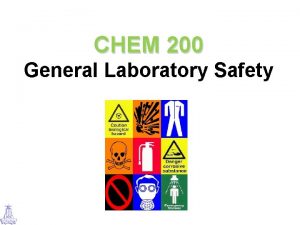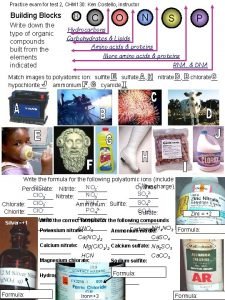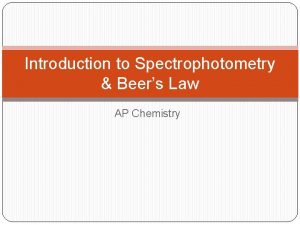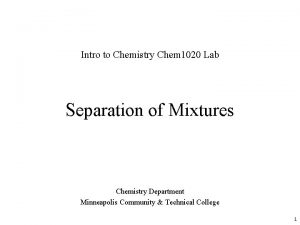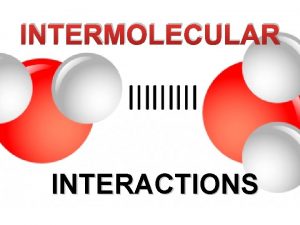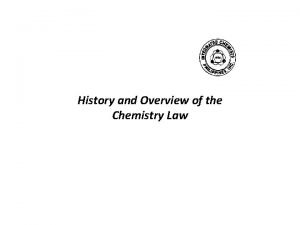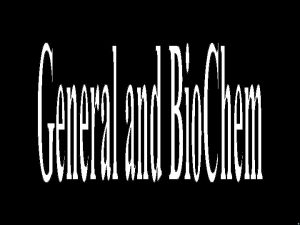CHEM 200 Chapter 5 CHEM 200 Chapter 2


















- Slides: 18

CHEM 200 Chapter 5 CHEM 200 Chapter 2 General Work Practices 1

• The hazards of chemicals vary widely and appropriate caution must always be used. • Every chemical can be hazardous in certain circumstances. • An understanding of the hazards of chemicals and how they enter the body can help those working with chemicals devise procedures to work with them safely. Basic Principle of Chemical Safety There is one important issue when it comes to chemical safety, which is “What ever you don’t contact (either by eating, breathing, or by skin) is not harmful”. CHEM 200 Chapter 5 CHEM 200 Chapter 2 General Work Practices 2

Physical Hazards Combustible liquid: Any liquid, or mixture with 1% or more of a liquid, with a flashpoint above 60 °C but below 93°C. Compressed gas: A gas or gas mixture with an absolute pressure exceeding 40 p. s. i. at 21°C, or exceeding 104 p. s. i. at 54°C, or a liquid having a vapor pressure exceeding 40 p. s. i. at 38°C. Explosive: A chemical that causes a sudden, almost instantaneous release of gas, pressure, and heat when subjected to sudden shock, high temperature or pressure. Unstable: Any material, which will vigorously decompose, polymerize, condense, or will become self reactive when exposed to conditions of shock, pressure, or temperature. Water-reactive: A material which can react with water or steam to produce a gas which is either toxic or flammable. 3

Physical Hazards Flammable: Aerosol: A material that can produce a flame or flashback from a valve opening. Gas: Any gas at ambient conditions that will cause a flammable mixture with air in concentrations of 13% or less. Liquid: Any liquid, or mixture with 1% or more of a liquid, with a flash point below 61°C. Solid: A material that is liable to cause fire through friction, contact with moisture, spontaneous reaction, or retained heat, or which can be readily ignited and burns with enough persistence or violence to cause a serious health hazard. Organic peroxides: An organic compound with a bivalent O-O structure. Oxidizer: A chemical that initiates or supports combustion of other materials, causing fire by itself or by the release of oxygen or other gasses. Pyrophoric: A material that will ignite spontaneously in air at or below 55°C. 4

• Health Hazards It is very important to study few terms before explaining the different health hazards of chemicals. • Toxicology is a science that combines biology and chemistry to study poisons and their effect on biological systems. It is the study of the adverse effects of a toxicant on living organisms. • Toxicity is the ability of a chemical molecule or compound to produce harmful effect once it reaches a susceptible site in or on the body. 5

Factors Affecting Toxicity (1) Dose: Perhaps the single most significant factor of concern is the amount of exposure to the chemical. • An exposure to a large amount of the chemical is usually of more concern than exposure to a small amount. • For most chemicals, there is a level of exposure below which no adverse effects are likely to be observed. • The LD 50 is a standardized measure for expressing and comparing the toxicity of chemicals. • The LD 50 is the dose that kills half (50%) of the animals tested (LD = "lethal dose"). • The animals are usually rats or mice, although rabbits, guinea pigs, hamsters, and so on are sometimes used. 6

Chemical Ethyl Alcohol Sodium Chloride Ferrous Sulfate Morphine Sulfate Strychnine Sulfate Nicotine Black Widow Curare Rattle Snake Dioxin (TCDD) Botulinum toxin LD 50 (mg/kg) 10, 000 4, 000 1, 500 900 150 1 0. 55 0. 50 0. 24 0. 001 0. 0001 7

Factors Affecting Toxicity (2) Toxicity: Chemicals vary widely in how toxic (poisonous) they are. Exposure to small amounts of highly toxic chemicals can be a greater danger than exposure to large amounts of less toxic chemicals. (3) Duration and frequency: One-time exposures that are of short duration are of less concern than multiple exposures of long duration, all other factors being equal. Thus, when there has been a chemical exposure, an important piece of information concerns duration and frequency. 8

Dose Response Relationships Duration is not the only significant aspect of exposure. One of the most important questions that toxicologists ask about exposure is — “how much? ” This is called the DOSE. This is important because for each chemical, a certain dose produces certain biological effects in the individual organism. Any biological effect caused by the exposure is called the RESPONSE. Most of the time, the greater the dose, the greater the response (as shown in the figure), but this is not always true. 9

Factors Affecting Toxicity (4) Synergistic effects: Many situations involve exposure to two or more chemicals at the same time. When this happens, it is possible that the combined exposures are more hazardous than what one might expect from simply adding the two effects together. While information to exposures to a single chemical is often available, good information on the possible toxic effects to chemical mixtures is often not available. (5) Individual characteristics: Each person is unique. While there are many similarities in response to chemical exposures, responses may vary dramatically among individuals. For examples, males can react differently than females. Special concern is often given for women who are pregnant. Some individuals are allergic or hypersensitive to certain chemicals. (6) Acute and chronic effects: Acute effects are those that show up immediately after a chemical exposure occurs. Example: the spillage of acid on the skin--a chemical burn will occur immediately. Chronic effects are those that occur after a significant amount of time passes and usually are the result of multiple exposures over a period of time. Cancer is a typical example of a chronic effect because cancers caused by chemical exposures often do not show up until 20 or more years after the initial 10 exposure.

Routes of Exposure Inhalation Ingestion Direct (skin/eye) contact hazards Injection 11

Routes of Exposure (1) Inhalation hazards: It is the most common route of entry a chemical can take to enter the body. Chemicals that could be inhaled include: gases, the vapors of volatile liquids, mists and sprays of both volatile and nonvolatile liquid, substances, solid chemicals in the form of particles, fibers, and dusts. (2) Direct (skin/eye) contact hazards: Many chemicals (e. g. corrosives) can injure the skin directly, while others may cause irritation or an allergic reaction. In addition to causing local toxic effects, many chemicals may be absorbed through the skin and/or eyes in sufficient quantity to cause systemic effects. Direct contact effects and absorption of chemicals through the skin depend on a number of factors, including: chemical concentration, chemical reactivity, the solubility of the chemical in fat and water, the condition of the skin, the duration of contact. 12

Routes of Exposure (3) Ingestion hazards: Ingestion of chemicals is a less common route of entry into the body. However, persons using chemicals can easily ingest chemicals into the body via contaminated hands if they are not washed prior to eating, drinking, smoking, applying cosmetics, or sticking part of the hand or a writing tool that has become contaminated into the mouth. (4) Injection hazards: This route is the least likely for chemical exposures. Accidental injection of chemicals through needles is unlikely. However, if needles are contaminated or contaminated glassware breaks, there is the possibility of injecting chemicals into the body. Injections can also occur through high pressure streams of liquids or gases. 13

OSHA Health Hazard Classes Carcinogen: A material which causes or potentially causes cancer. Corrosives: Chemicals that cause visible destruction of, or irreversible alterations in, living tissue by chemical action at the site of contact. Irritants: Chemicals which are not corrosive, but which cause reversible inflammatory effects on living tissue at the site of contact. Mutagen: A material that damages chromosomes. Sensitizer: A chemical, which will cause an allergic reaction in a substantial number of exposed people. Target organ effects: - Cutaneous hazards: damage the skin - Eye hazards: damage the eye 14

OSHA Health Hazard Classes Target organ effects: - Cutaneous hazards: damage the skin - Eye hazards: damage the eye - Hematopoetic toxins: damage the blood and/or blood forming organs - Hepatotoxic: damage the liver - Nephrotoxic: damage the kidneys - Neurotoxins: damage the nervous system - Pulmonary toxins: damage the lungs - Reproductive toxins: affect the fetus Teratogen: A material that causes birth defects Toxic: A chemical with an oral lethal dose of 50 -500 mg/kg, a cutaneous lethal dose of 200 -1000 mg/kg, or a lethal concentration in air of 200 -2000 ppm. Highly toxic: A material with an oral lethal dose of <50 mg/kg, a cutaneous lethal 15 dose of <200 mg/kg, or lethal concentration in air at <200 ppm.

Controlling Chemical Exposures (1) Engineering controls: such as changing the procedures or substituting less hazardous materials for more hazardous materials. Conducting work with hazardous chemicals in a fume hood or glove box, and providing secondary containment in the event of spills are examples of engineering controls. (2) Administrative controls: It require that workers take active steps. Examples of administrative controls are posting hazard signs on laboratory doors, minimizing exposure time when working with hazardous chemicals, restricting access to areas where hazardous chemicals are used, working with highly odorous chemicals during nonoffice hours, and adopting standard operating procedures like those listed in Chapter 3. (3) Personal protective equipment: Personal protective equipment includes items such as gloves, eye protection, suitable clothing, and respirators. 16

Safety Storage of Chemical There are many different regulations for the safe storage of chemicals in laboratories and in general, store materials and equipment in cabinets and on shelving provided for such storage: 1 - Avoid storing materials and equipment on top of cabinets. 2 - Be sure that the weight of the chemicals does not exceed the load capacity of the shelf or cabinet. 3 - Wall-mounted shelving must have heavy-duty brackets and standards. 4 - Cabinets for chemical storage must be of solid, sturdy construction, preferably hardwood or metal. 5 - Do not store materials on top of high cabinets where they will be hard to see or reach. 6 - Do not store corrosive liquids above eye level. 7 - Provide a specific storage location for each type of chemical, and return the 17 chemicals to those locations after each use.

Safety Storage of Chemical 8 - Avoid storing chemicals in the workspace within a laboratory fume hood, except for those chemicals currently in use. 9 - If a chemical does not require a ventilated cabinet, store it inside a closable cabinet or on a shelf that has a lip to prevent containers from sliding off in the event of an accident or fire. 10 - Do not expose chemicals to heat or direct sunlight. 11 - Observe all precautions regarding the storage of incompatible chemicals. 12 - Use corrosion resistant storage trays or secondary containers to collect materials if the primary container breaks or leaks. 13 - Distinguish between refrigerators used for chemical storage and refrigerators used for food storage. Each refrigerator should be labeled "No Food" or "Food Only". 14 - Do not store flammable liquids in a refrigerator unless it is approved for such storage. 15 - Chemical storage cabinets located outside the laboratory (e. g. , in hallways) 18 should be labeled with the name of the laboratory group that owns and uses it.
 200 + 200 + 300
200 + 200 + 300 Chem 200
Chem 200 200+200+100+100
200+200+100+100 600+800+800
600+800+800 300+300+200+200
300+300+200+200 100 200 300
100 200 300 100 200 300
100 200 300 100 200 300
100 200 300 Iannone chem moodle
Iannone chem moodle Ap chemistry thermochemistry frq
Ap chemistry thermochemistry frq Types of intermolecular forces
Types of intermolecular forces Chm 130 chapter 12 practice problems answer key
Chm 130 chapter 12 practice problems answer key Eth meth table
Eth meth table Kmt chem
Kmt chem Chemistry january 2018 answers
Chemistry january 2018 answers Beer's law formula
Beer's law formula Chem 1020
Chem 1020 Dipole induced dipole
Dipole induced dipole Chem law hazard pay
Chem law hazard pay

